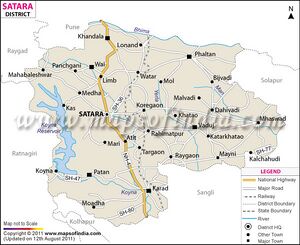Satara

Satara (सतारा) is a town and District of Maharashtra.
Location
The town is near the confluence of the Krishna and its tributary river Venna.
Origin of name
The name of the city is derived from the seven hills surrounding the city. Saat (सात) meaning seven and Tara (तारा) meaning hill, thus forming the word 'Satara'.
Tahsils
Satara district consists of 11 tahsils: Satara, Karad, Wai, Mahabaleshwar, Phaltan, Man, Khatav, Koregaon, Patan, Jaoli and Khandala.
History
Historical inscriptions as old as 200 BCE indicate the oldest known place in Satara district in Maharashtra is Karad (mentioned as Karhakada). It is also believed that the Pandavas stayed in Wai, then known as 'Viratnagari', in the 13th year of exile.
Satara District can be proud of the oldest Rashtrakuta history. The oldest Rashtrakutas are believed to be from ancient Kuntala in the valley of river Krishna. Manank ruled from 350 - 375 C.E. and had built his capital in Manpur (now Maan in Satara district). The Vakatakas of Vidarbha, another Rashtrakuta rulers were in conflict with Manank. Subsequently the Rashtrakutas became feudatories to the Chalukyas and came into prominence under Dantidurga around 753 CE.
Notable persons
- Sajjan Singh was a Balyan clan Ruler of Satara in Maharashtra.[1]
External links
References
- ↑ Asli Lutere Koun/Part-I,p.65
Back to Maharashtra

